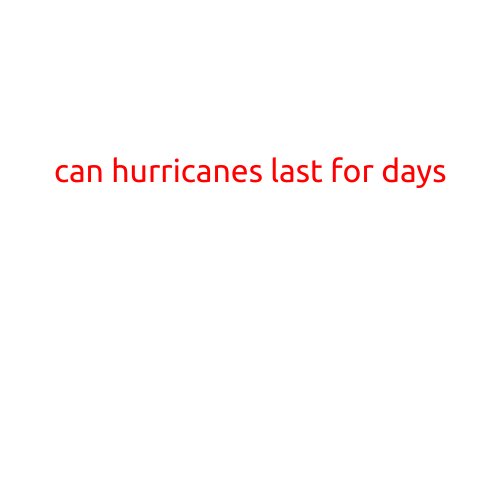
Can Hurricanes Last for Days?
Hurricanes are powerful and destructive natural disasters that can bring significant damage to coastal communities. One question that often arises in the minds of people living in hurricane-prone areas is: can hurricanes last for days? The answer is a resounding yes.
Hurricanes can indeed last for days, and sometimes even longer. The duration of a hurricane is measured by its latitude, wind speed, and forward speed. A hurricane’s life cycle typically consists of three stages: formation, maturity, and dissipation.
Formation Stage
A hurricane forms over warm ocean waters, typically in the tropics. As the storm develops, it gathers strength and size, fueled by the warm waters and atmospheric conditions. During this stage, the hurricane’s wind speed and rain bands begin to take shape, and it starts to exhibit characteristic cloud formations.
Maturity Stage
Once a hurricane reaches its maturity stage, it begins to intensify, with wind speeds reaching their maximum. This is often the most destructive stage of the storm, as the strong winds and heavy rainfall can cause significant damage to buildings, infrastructure, and the environment. During this stage, the hurricane is usually at its closest to land, with the eyewall, the area of the most intense winds and rainfall, often making landfall.
Dissipation Stage
As the hurricane moves away from land or encounters cooler waters, it begins to weaken and lose steam. The winds slow down, and the rainbands dissipate. This is the final stage of the hurricane’s life cycle, and it often marks the end of the storm’s destructive path.
Duration of Hurricanes
The duration of a hurricane can vary greatly, depending on several factors such as:
- Latitude: Hurricanes that form closer to the equator tend to last longer than those that form at higher latitudes.
- Wind speed: Stronger hurricanes tend to last longer than weaker ones.
- Forward speed: Hurricanes that move slowly over land or water tend to last longer than those that move quickly.
On average, a hurricane can last anywhere from a few days to a week or more. Some hurricanes have been known to last up to 14 days or even longer. The longest-lasting hurricane on record is Hurricane John, which lasted an astonishing 31 days in 1994.
Why Can Hurricanes Last for Days?
Several factors contribute to a hurricane’s ability to last for days:
- Warm ocean waters: The warm waters of the tropics provide the necessary energy and moisture for a hurricane to sustain itself.
- Atmospheric conditions: A hurricane’s size and strength are influenced by atmospheric conditions such as humidity, temperature, and wind direction.
- The Coriolis effect: This natural phenomenon, caused by the Earth’s rotation, helps to steer a hurricane and maintain its wind circulation.
Conclusion
Hurricanes can indeed last for days, and it’s crucial for people living in hurricane-prone areas to be prepared and aware of the storm’s potential duration. By understanding the factors that contribute to a hurricane’s longevity, residents can take necessary precautions to ensure their safety and minimize the impact of the storm.





